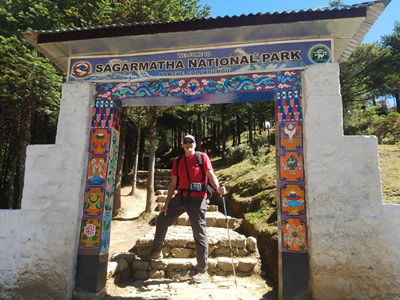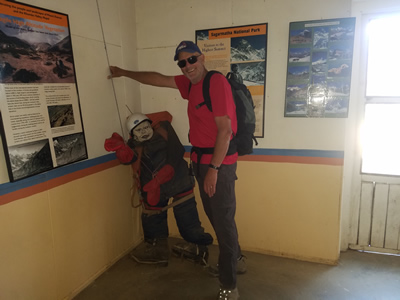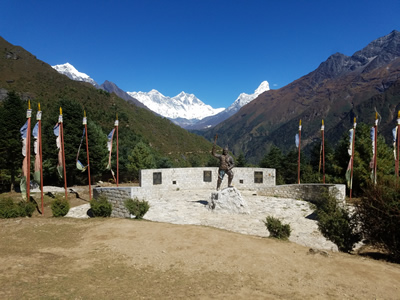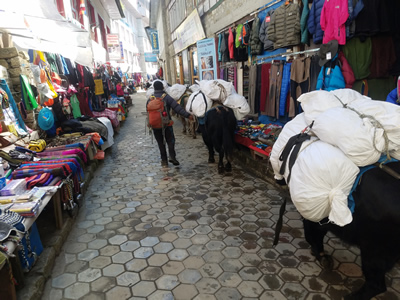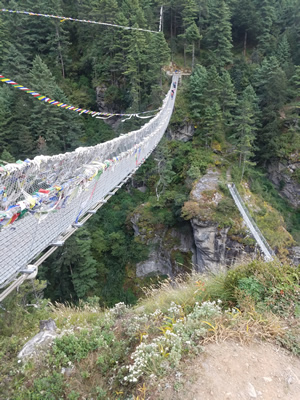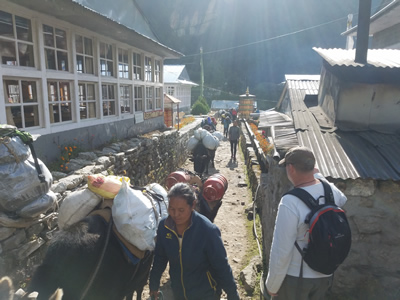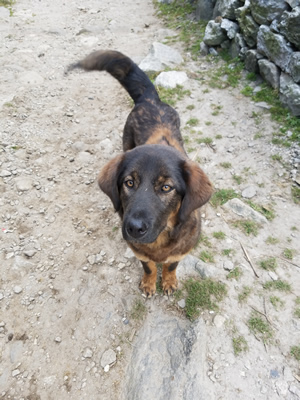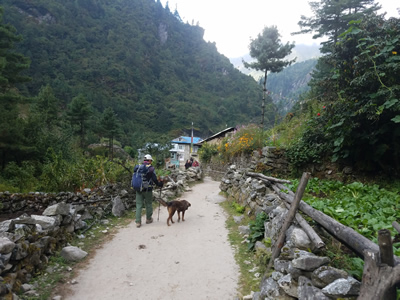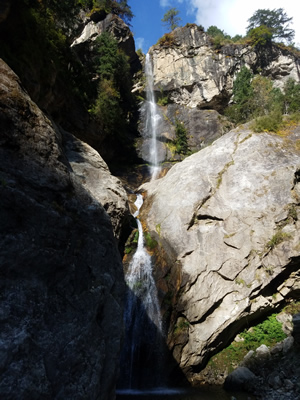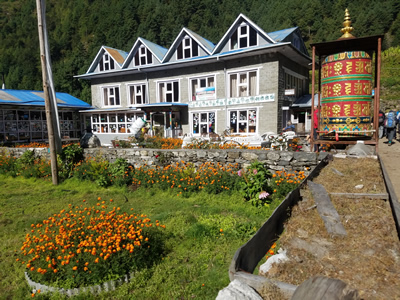Nepal Pt14: Home Stretch
We spent the morning walking from Tengboche to Namche Bazaar. It's a magnificent hike, maybe the most famous section of trail in the Himalayas. There were incredible views all morning of beautiful and famous mountains like Ama Dablam, Lhotse, and Kusum Kanguru. Even the very top of Everest was visible, poking up from behind the Lhotse Wall. We weren't alone though. There were many, many hikers who came to enjoy the scenic splendor and make their pilgrimage to Mt. Everest. And yaks. There were lots of yaks, as you can see in this video.
We got to Namche around noon. Since we passed near the national park visitor center and museum on the way into town, Shambu asked if I wanted to stop in and visit. We had tried before when we stayed in Namche on the way up but because it was a Saturday it had been closed. This was a difficult choice because while I wanted to see it, especially after failing on our first try, I had to admit that I was pretty hungry after our morning hike. I decided to tough it out.
The short climb to the top of Chorkhung Hill turned out to be worth it. There were some interesting displays on the history of Namche and the national park. Out back was a statue of Tenzing Norgay and this time, with the clear weather, the mountains provided an appropriate backdrop for the memorial.
Tenzing was a Sherpa who made the first ascent of Mt. Everest in 1953 with Edmund Hillary. Which one of them reached the summit first became a subject of much debate after the climb for political reasons. Because the climb occured just as Queen Elizabeth was crowned, the British press was anxious to laud Hillary for the first ascent. People in Nepal and India wanted to tout Tenzing as the true conquerer of Mt. Everest. Both Hillary and Tenzing (who were lifelong friends) insisted that they climbed the mountain together and for many years neither would say which of them had actually stepped onto the summit first. After Tenzing's death in 1986, Hillary did admit that he had been the first one on the summit, although only by a moment, and that it really didn't matter. Climbers would all readily agree. Since they were a rope team, both Tenzing and Hillary get equal credit for the first ascent.
Lunch in Namche was at the Yak Hotel again. While we were eating I got a surprise. They brought me the tshirt and hankies that was missing from the laundry I had done during my first stay. Although I really didn't need them anymore I thought it was nice of them to hold on to my stuff for a week so they could return it to me when I came back. Then I got my lunch bill and found out they charged me for them. No wonder they had gone through the trouble. They wanted to be paid!
After lunch I told Shambu I wanted to spend an hour in town. There are a lot of shops and on our first time through I had seen a lot of things that I wanted to buy. I didn't get them because it would have meant that Awshuk would have to carry my purchases around the Khumbu for over a week. Now we only had to get them to Lukla. I still had a limit. Since Awshuk had gone ahead, I had to carry anything that I bought in my daypack for the rest of the day.
First on my list was a nice hiking shirt I had seen. It was made locally and even had a cool "Sherpa" logo. I thought about it while we were up high, trying to decide whether I would get the blue one or the green one. I finally just made up my mind to get both. When I went back to the shop they were busy helping someone else. It was a tiny place with boxes of merchandise stacked everywhere so I waited outside. There wasn't room for more than one customer at a time.
While I was waiting I started looking at some of the things in the shop across the street. After all, across the street was only five feet away. A jacket there caught my eye. The shopkeeper noticed my interest and hustled me inside and convinced me to try it on. Before I knew it I had bought the jacket. Turned out to be a good decision because I've worn it as my everyday fall jacket since I got home and I love it. Meanwhile the shirt I had been thinking about getting all week didn't really fit me when I tried it on.
I made a few more stops and bought a baseball cap, a tshirt and a warm hat. By then my pack was full so I decided that I was done shopping. It was time to get back on the trail.
When we left Namche we were back on familiar ground, retracing the steps we had taken on the way in ten days before. The hill below Namche that dropped to the river was a lot easier going down than it was going up, but it was still a big hill and took a long time.
This was our last really big downhill and I was glad that my knees had held up so well. I hiked for decades and never worried about going downhill until a few years ago one of my knees started to give me problems. It's never been really bad but I now I do have to watch it. I even wear a light knee brace sometimes when I hike. In the first few days of the trek that wasn't enough. With all the steep ups and downs my knee started to bother me a little. Since I still had a lot of trekking ahead of me I decided to try something radical.
I have never been a fan of trekking poles although a lot of hikers swear by them. In fact if you just mention the word trekking it conjures up an image of a hiker power-striding down the trail, a trekking pole in each hand. Well I never liked them and I don't use them. I've tried them and they seem to take up way too much energy while I'm hiking. I feel like I'm working as hard at swinging the poles around as I am at walking. I own a nice set of trekking poles but I hadn't bothered to bring them along on the trip.
I noticed that Shambu only used one trekking pole instead of two. He also only used it on steep slopes. When he was on level trails or moderate slopes he just carried it on his pack. I talked to him about it and he suggested that I try using a single pole. Trekking poles do help take some of the stress off of your knees, especially when hiking downhill. I figured it was worth a try to see if it would keep my knee from getting worse and affecting the trek.
When we first passed through Namche Bazaar on our way up, Shambu took me to a high end mountain shop. The guy there showed me some super high tech poles that were really nice. They were also really expensive, like 60 USD each. Since this was just an experiment, and one that I didn't really expect to work, I asked about cheaper poles. The salesman was disappointed but he showed me some cheaper ones. Then I told him that I only wanted to buy one and not the set. I ended up getting a single pole for 15 USD.
I have to admit that it worked really well. I did the same as Shambu and carried it on my pack when I didn't need it, which was probably half the time. When I did use it, I could reduce the impact that I felt in my knee. Since it's my left knee that bothers me sometimes, I made a point of always carrying the pole in my left hand. That's not a natural thing for me to do since I am strongly right handed, but once I got used to it the pole seemed to help my rhythm while I walked. Since I was only using a single pole it didn't feel like I was moving my arms a lot and expending extra energy while I used it. I really liked it and ended up becoming a convert.
Besides helping protect my knee, my new trekking pole came in especially handy on the glacier when I was descending from the Cho La pass. Although not as good as an ice axe, it still provided some extra security on the snow slopes. Now it came in handy once again on the steep downhill from Namche. Even when I got back to the US and did a big hike in the Grand Canyon (which I'll cover it in a future post), I used my new trekking pole the whole time.
Just before reaching the Dudh Khosi River we had to cross the one hundred meter high Larja Dhoban suspension bridge again. When we were hiking in we could see it from far down river and get a good view of just how high up it was and and how precarious it looked. On the way down you don't see it until the last moment. You don't get a sense for its height until you step out onto it and see that it's a looooong way down to the river. It's a different experience. Instead of long anticipation before you cross you just suddenly find your self suspended in midair.
Once we crossed the bridge and were down to the river, we were out of the high country and back in the apporach valleys. The rest of the way to Lukla there were the usual ups and downs (and there were a lot of them) but no more monster hills. There was the back and forth crossing of the river on suspension bridges but none were quite as exciting as the one at Larja Dhoban. Even the "normal" ones were still impressive and fun to cross, as shown in this video of a crossing just above Phakding. There were still some yaks on the trail but now we also had to deal with the long lines of horses carrying loads again. We passed large groups of trekkers who had just gotten off the plane in Lukla. There were lots of trekkers and porters and animals and locals on the trail. There were even traffic jams, as shown in this video.
Although the way was familiar it was longer than I remembered. It was late afternoon when we finally reached Monjo where we stopped at the same teahouse as before to spend the night. This time I passed on the shower. Hey, it had only been a day since my last one. No sense in going crazy about personal hygiene.
There was one other person staying at our lodge that night. He was an American mountain guide named Mike who was from Montana. He was on his way to the Khumbu Climbing Center. He was going to spend the next six weeks teaching climbing techniques to Nepali mountaineers. It sounded like a fun gig and it probably really helped a lot of the Sherpas who work as high altitude porters and climbing guides. Their profession is dangerous and there is no social safety net in Nepal. Training that can help them avoid accidents and climb safely is a good thing.
The next morning we started at 7 am. It was the last day of the trek and I had mixed feelings. I was enjoying the trek immensely and was sorry to have it end but I had also been gone from home for a long time and was anxious to get back. I decided that I would just enjoy the day.
A lot of the places we walked by were familiar from when we were hiking up. We passed the beautiful double waterfall again. Last time it had been in the shadows. This time it was even more impressive in the bright morning sun.
As we passed through villages there seemed to be a lot more kids. And dogs. Whenever there was a dog along the trail I would stop to take a picture and make friends. I guess I missed my dog, Abby. One dog in particular was really friendly and followed us for quite a while. He had a huge scar on his back from an old wound. He must have been hurt badly a long time ago but I have to give him a lot of credit. He was still a friendly and happy dog.
We passed through Phakding and I asked Shambu if he wanted to take a break and stop at the teahouse run by his neighbor again. He said no. He explained that it is a lot of work to run a teahouse. In the morning they make breakfast. Then they make lunch. In the afternoon is the only time that they have to clean the rooms, after their guests leave but before new guests arrive. If we stopped she would be polite and visit with him. He didn't want to disrupt her routine. I can certainly believe that running a teahouse would be a very demanding business and require a lot of hard work.
Eventually we reached a trail junction. On the right was the trail that we had come up from Salleri almost two weeks before. We turned left and took the trail to Lukla. Of course the last hour was all uphill.
When we had left Monjo early that morning we passed a sign that said it was six hours to Lukla. We made it in five hours and that included a half hour stop. I guess I really was in a hurry to get home. Bistari, bistari my ass.
